Software Development Life Cycle Models
VerifiedAdded on 2020/03/16
|12
|2727
|288
AI Summary
This assignment delves into various Software Development Life Cycle (SDLC) models, examining both adaptive and predictive approaches. It explores the distinct phases within each model and highlights the core principles guiding successful software development. Resources provided cover topics such as non-functional requirements, cloud computing integration, and the importance of understanding different SDLC methodologies.
Contribute Materials
Your contribution can guide someone’s learning journey. Share your
documents today.
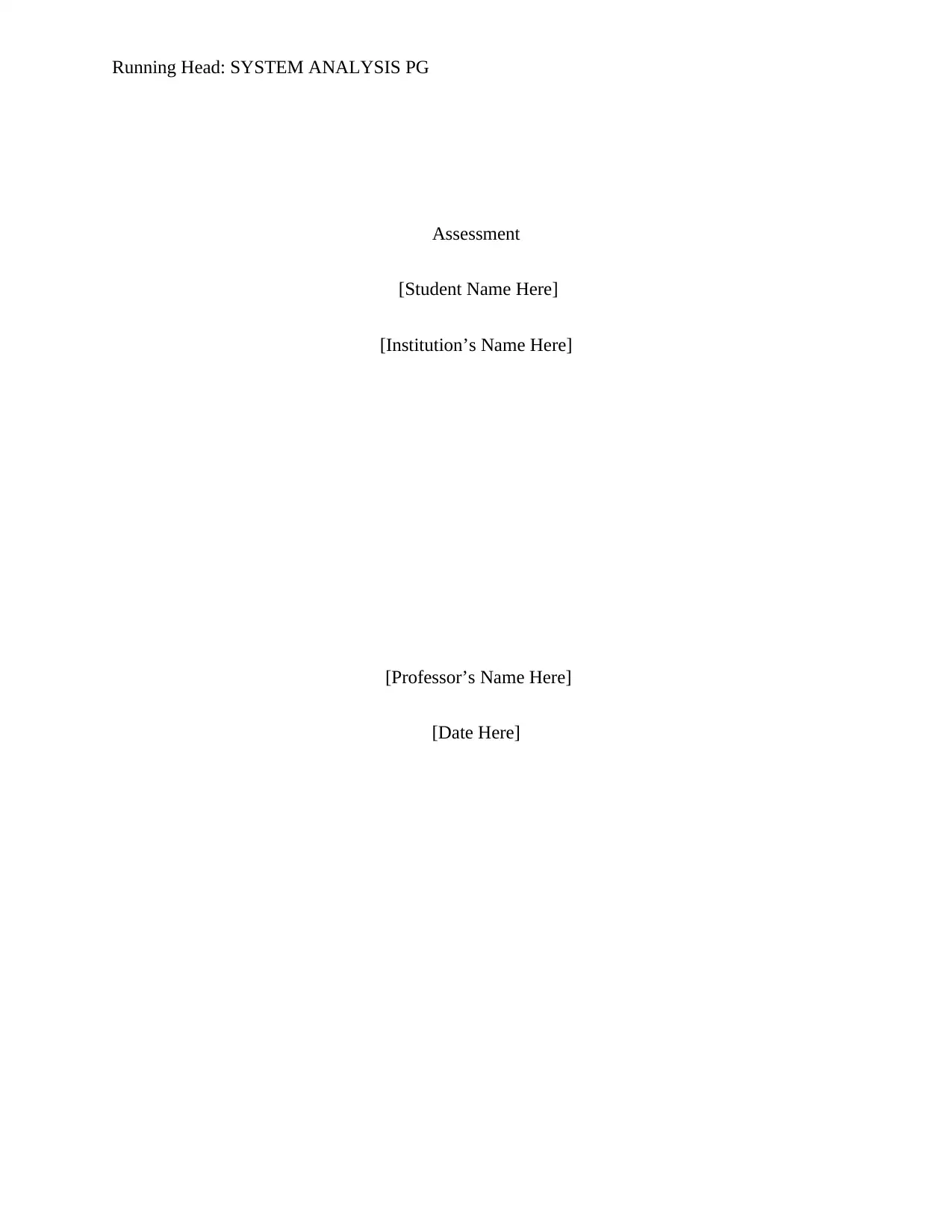
Running Head: SYSTEM ANALYSIS PG
Assessment
[Student Name Here]
[Institution’s Name Here]
[Professor’s Name Here]
[Date Here]
Assessment
[Student Name Here]
[Institution’s Name Here]
[Professor’s Name Here]
[Date Here]
Secure Best Marks with AI Grader
Need help grading? Try our AI Grader for instant feedback on your assignments.
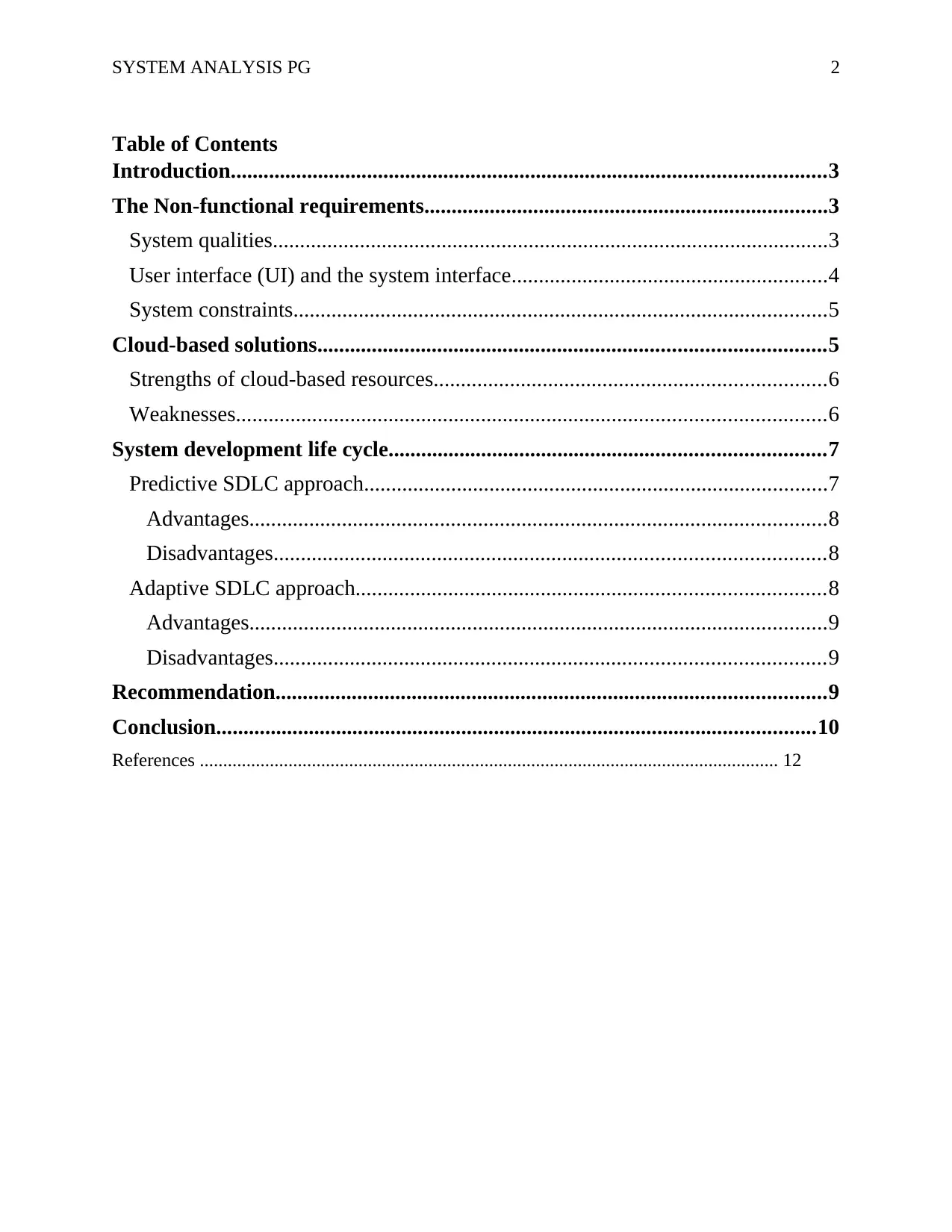
SYSTEM ANALYSIS PG 2
Table of Contents
Introduction.............................................................................................................3
The Non-functional requirements..........................................................................3
System qualities......................................................................................................3
User interface (UI) and the system interface..........................................................4
System constraints..................................................................................................5
Cloud-based solutions.............................................................................................5
Strengths of cloud-based resources........................................................................6
Weaknesses............................................................................................................6
System development life cycle................................................................................7
Predictive SDLC approach.....................................................................................7
Advantages..........................................................................................................8
Disadvantages.....................................................................................................8
Adaptive SDLC approach......................................................................................8
Advantages..........................................................................................................9
Disadvantages.....................................................................................................9
Recommendation.....................................................................................................9
Conclusion..............................................................................................................10
References ............................................................................................................................ 12
Table of Contents
Introduction.............................................................................................................3
The Non-functional requirements..........................................................................3
System qualities......................................................................................................3
User interface (UI) and the system interface..........................................................4
System constraints..................................................................................................5
Cloud-based solutions.............................................................................................5
Strengths of cloud-based resources........................................................................6
Weaknesses............................................................................................................6
System development life cycle................................................................................7
Predictive SDLC approach.....................................................................................7
Advantages..........................................................................................................8
Disadvantages.....................................................................................................8
Adaptive SDLC approach......................................................................................8
Advantages..........................................................................................................9
Disadvantages.....................................................................................................9
Recommendation.....................................................................................................9
Conclusion..............................................................................................................10
References ............................................................................................................................ 12
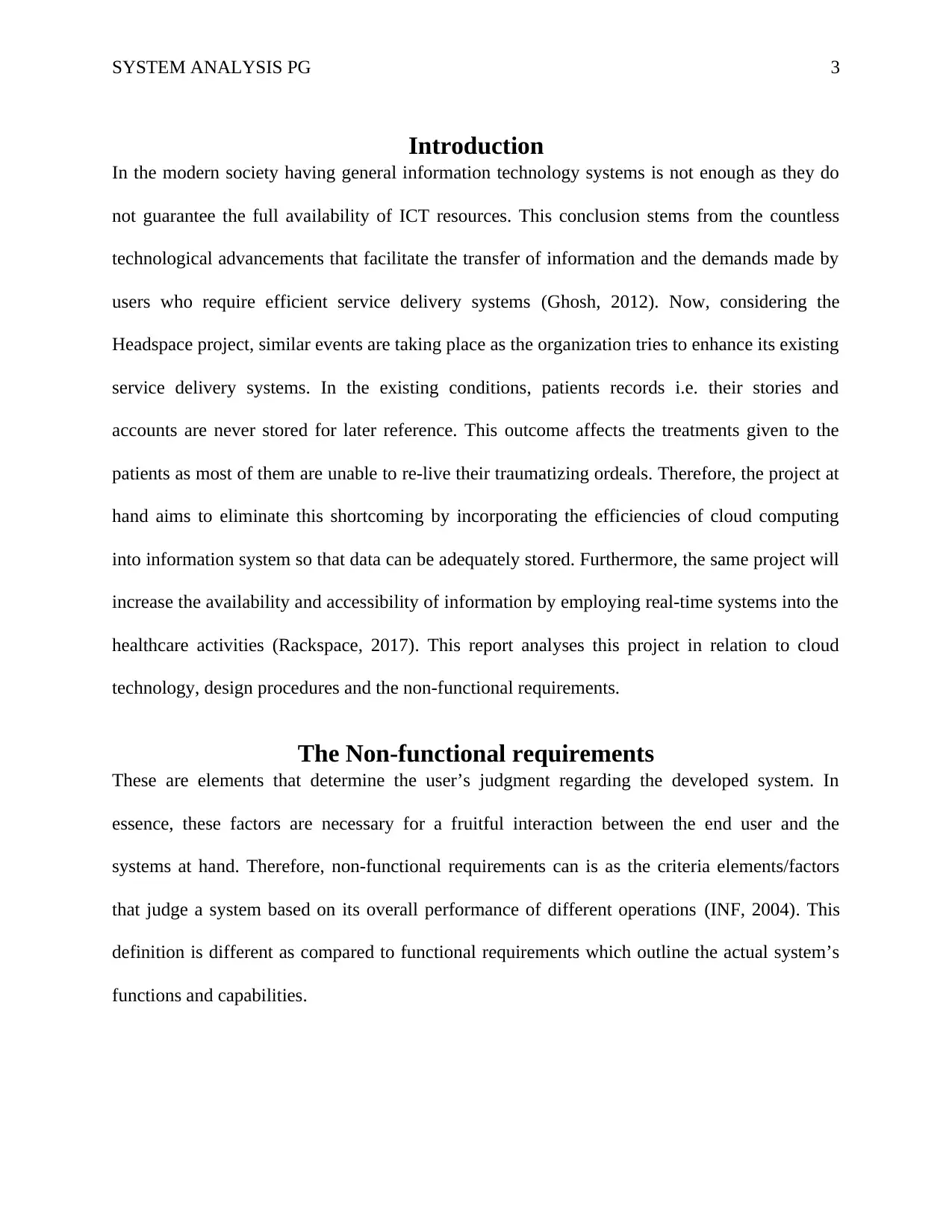
SYSTEM ANALYSIS PG 3
Introduction
In the modern society having general information technology systems is not enough as they do
not guarantee the full availability of ICT resources. This conclusion stems from the countless
technological advancements that facilitate the transfer of information and the demands made by
users who require efficient service delivery systems (Ghosh, 2012). Now, considering the
Headspace project, similar events are taking place as the organization tries to enhance its existing
service delivery systems. In the existing conditions, patients records i.e. their stories and
accounts are never stored for later reference. This outcome affects the treatments given to the
patients as most of them are unable to re-live their traumatizing ordeals. Therefore, the project at
hand aims to eliminate this shortcoming by incorporating the efficiencies of cloud computing
into information system so that data can be adequately stored. Furthermore, the same project will
increase the availability and accessibility of information by employing real-time systems into the
healthcare activities (Rackspace, 2017). This report analyses this project in relation to cloud
technology, design procedures and the non-functional requirements.
The Non-functional requirements
These are elements that determine the user’s judgment regarding the developed system. In
essence, these factors are necessary for a fruitful interaction between the end user and the
systems at hand. Therefore, non-functional requirements can is as the criteria elements/factors
that judge a system based on its overall performance of different operations (INF, 2004). This
definition is different as compared to functional requirements which outline the actual system’s
functions and capabilities.
Introduction
In the modern society having general information technology systems is not enough as they do
not guarantee the full availability of ICT resources. This conclusion stems from the countless
technological advancements that facilitate the transfer of information and the demands made by
users who require efficient service delivery systems (Ghosh, 2012). Now, considering the
Headspace project, similar events are taking place as the organization tries to enhance its existing
service delivery systems. In the existing conditions, patients records i.e. their stories and
accounts are never stored for later reference. This outcome affects the treatments given to the
patients as most of them are unable to re-live their traumatizing ordeals. Therefore, the project at
hand aims to eliminate this shortcoming by incorporating the efficiencies of cloud computing
into information system so that data can be adequately stored. Furthermore, the same project will
increase the availability and accessibility of information by employing real-time systems into the
healthcare activities (Rackspace, 2017). This report analyses this project in relation to cloud
technology, design procedures and the non-functional requirements.
The Non-functional requirements
These are elements that determine the user’s judgment regarding the developed system. In
essence, these factors are necessary for a fruitful interaction between the end user and the
systems at hand. Therefore, non-functional requirements can is as the criteria elements/factors
that judge a system based on its overall performance of different operations (INF, 2004). This
definition is different as compared to functional requirements which outline the actual system’s
functions and capabilities.
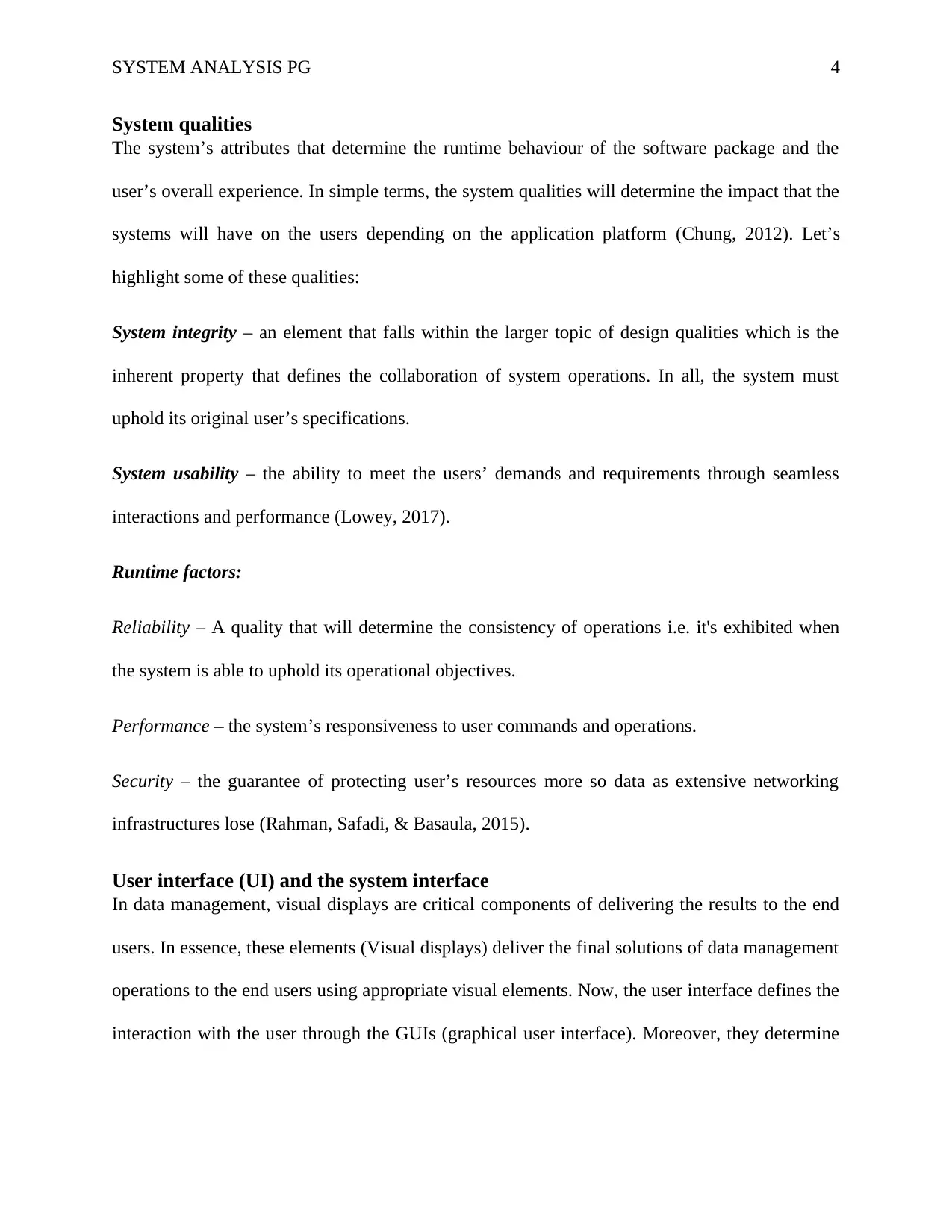
SYSTEM ANALYSIS PG 4
System qualities
The system’s attributes that determine the runtime behaviour of the software package and the
user’s overall experience. In simple terms, the system qualities will determine the impact that the
systems will have on the users depending on the application platform (Chung, 2012). Let’s
highlight some of these qualities:
System integrity – an element that falls within the larger topic of design qualities which is the
inherent property that defines the collaboration of system operations. In all, the system must
uphold its original user’s specifications.
System usability – the ability to meet the users’ demands and requirements through seamless
interactions and performance (Lowey, 2017).
Runtime factors:
Reliability – A quality that will determine the consistency of operations i.e. it's exhibited when
the system is able to uphold its operational objectives.
Performance – the system’s responsiveness to user commands and operations.
Security – the guarantee of protecting user’s resources more so data as extensive networking
infrastructures lose (Rahman, Safadi, & Basaula, 2015).
User interface (UI) and the system interface
In data management, visual displays are critical components of delivering the results to the end
users. In essence, these elements (Visual displays) deliver the final solutions of data management
operations to the end users using appropriate visual elements. Now, the user interface defines the
interaction with the user through the GUIs (graphical user interface). Moreover, they determine
System qualities
The system’s attributes that determine the runtime behaviour of the software package and the
user’s overall experience. In simple terms, the system qualities will determine the impact that the
systems will have on the users depending on the application platform (Chung, 2012). Let’s
highlight some of these qualities:
System integrity – an element that falls within the larger topic of design qualities which is the
inherent property that defines the collaboration of system operations. In all, the system must
uphold its original user’s specifications.
System usability – the ability to meet the users’ demands and requirements through seamless
interactions and performance (Lowey, 2017).
Runtime factors:
Reliability – A quality that will determine the consistency of operations i.e. it's exhibited when
the system is able to uphold its operational objectives.
Performance – the system’s responsiveness to user commands and operations.
Security – the guarantee of protecting user’s resources more so data as extensive networking
infrastructures lose (Rahman, Safadi, & Basaula, 2015).
User interface (UI) and the system interface
In data management, visual displays are critical components of delivering the results to the end
users. In essence, these elements (Visual displays) deliver the final solutions of data management
operations to the end users using appropriate visual elements. Now, the user interface defines the
interaction with the user through the GUIs (graphical user interface). Moreover, they determine
Secure Best Marks with AI Grader
Need help grading? Try our AI Grader for instant feedback on your assignments.
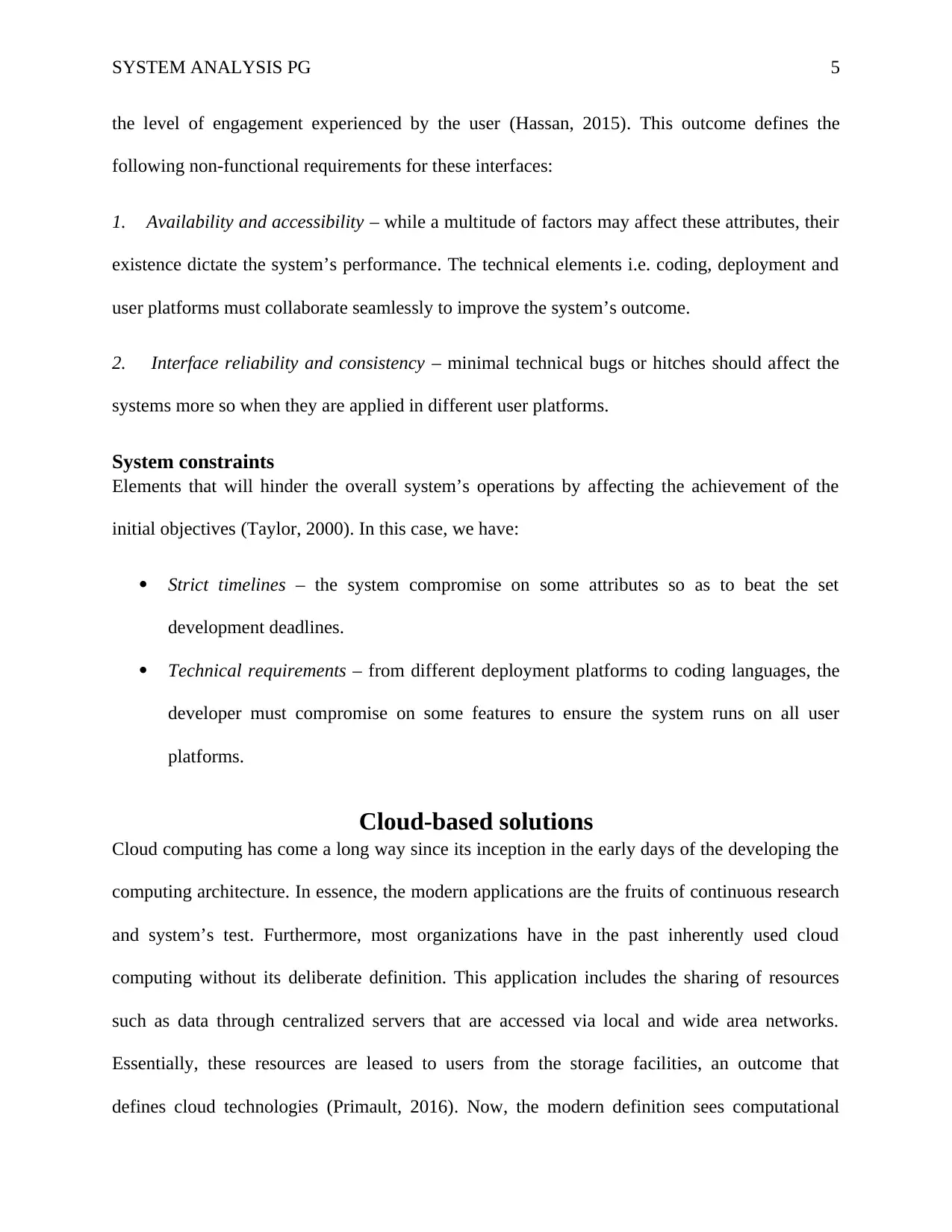
SYSTEM ANALYSIS PG 5
the level of engagement experienced by the user (Hassan, 2015). This outcome defines the
following non-functional requirements for these interfaces:
1. Availability and accessibility – while a multitude of factors may affect these attributes, their
existence dictate the system’s performance. The technical elements i.e. coding, deployment and
user platforms must collaborate seamlessly to improve the system’s outcome.
2. Interface reliability and consistency – minimal technical bugs or hitches should affect the
systems more so when they are applied in different user platforms.
System constraints
Elements that will hinder the overall system’s operations by affecting the achievement of the
initial objectives (Taylor, 2000). In this case, we have:
Strict timelines – the system compromise on some attributes so as to beat the set
development deadlines.
Technical requirements – from different deployment platforms to coding languages, the
developer must compromise on some features to ensure the system runs on all user
platforms.
Cloud-based solutions
Cloud computing has come a long way since its inception in the early days of the developing the
computing architecture. In essence, the modern applications are the fruits of continuous research
and system’s test. Furthermore, most organizations have in the past inherently used cloud
computing without its deliberate definition. This application includes the sharing of resources
such as data through centralized servers that are accessed via local and wide area networks.
Essentially, these resources are leased to users from the storage facilities, an outcome that
defines cloud technologies (Primault, 2016). Now, the modern definition sees computational
the level of engagement experienced by the user (Hassan, 2015). This outcome defines the
following non-functional requirements for these interfaces:
1. Availability and accessibility – while a multitude of factors may affect these attributes, their
existence dictate the system’s performance. The technical elements i.e. coding, deployment and
user platforms must collaborate seamlessly to improve the system’s outcome.
2. Interface reliability and consistency – minimal technical bugs or hitches should affect the
systems more so when they are applied in different user platforms.
System constraints
Elements that will hinder the overall system’s operations by affecting the achievement of the
initial objectives (Taylor, 2000). In this case, we have:
Strict timelines – the system compromise on some attributes so as to beat the set
development deadlines.
Technical requirements – from different deployment platforms to coding languages, the
developer must compromise on some features to ensure the system runs on all user
platforms.
Cloud-based solutions
Cloud computing has come a long way since its inception in the early days of the developing the
computing architecture. In essence, the modern applications are the fruits of continuous research
and system’s test. Furthermore, most organizations have in the past inherently used cloud
computing without its deliberate definition. This application includes the sharing of resources
such as data through centralized servers that are accessed via local and wide area networks.
Essentially, these resources are leased to users from the storage facilities, an outcome that
defines cloud technologies (Primault, 2016). Now, the modern definition sees computational
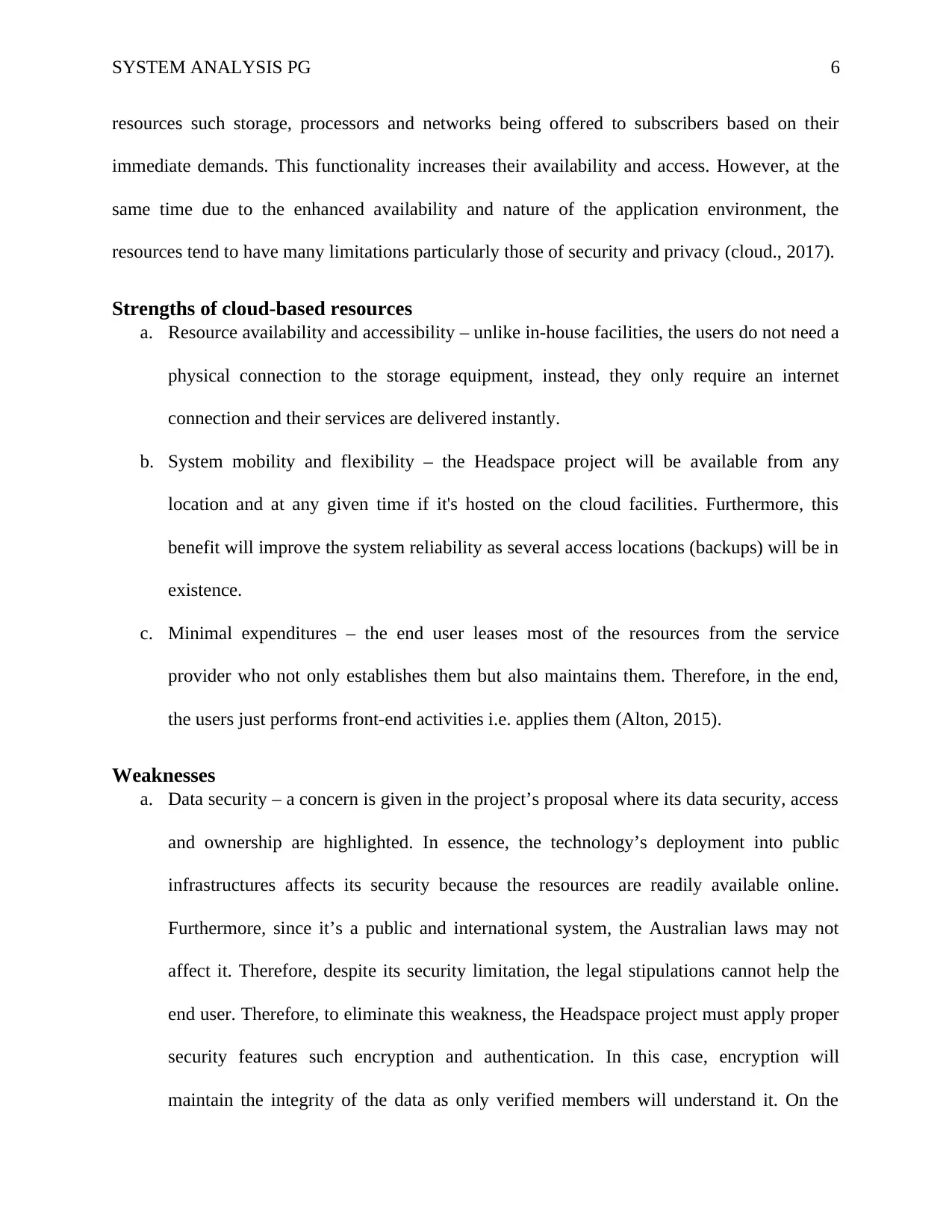
SYSTEM ANALYSIS PG 6
resources such storage, processors and networks being offered to subscribers based on their
immediate demands. This functionality increases their availability and access. However, at the
same time due to the enhanced availability and nature of the application environment, the
resources tend to have many limitations particularly those of security and privacy (cloud., 2017).
Strengths of cloud-based resources
a. Resource availability and accessibility – unlike in-house facilities, the users do not need a
physical connection to the storage equipment, instead, they only require an internet
connection and their services are delivered instantly.
b. System mobility and flexibility – the Headspace project will be available from any
location and at any given time if it's hosted on the cloud facilities. Furthermore, this
benefit will improve the system reliability as several access locations (backups) will be in
existence.
c. Minimal expenditures – the end user leases most of the resources from the service
provider who not only establishes them but also maintains them. Therefore, in the end,
the users just performs front-end activities i.e. applies them (Alton, 2015).
Weaknesses
a. Data security – a concern is given in the project’s proposal where its data security, access
and ownership are highlighted. In essence, the technology’s deployment into public
infrastructures affects its security because the resources are readily available online.
Furthermore, since it’s a public and international system, the Australian laws may not
affect it. Therefore, despite its security limitation, the legal stipulations cannot help the
end user. Therefore, to eliminate this weakness, the Headspace project must apply proper
security features such encryption and authentication. In this case, encryption will
maintain the integrity of the data as only verified members will understand it. On the
resources such storage, processors and networks being offered to subscribers based on their
immediate demands. This functionality increases their availability and access. However, at the
same time due to the enhanced availability and nature of the application environment, the
resources tend to have many limitations particularly those of security and privacy (cloud., 2017).
Strengths of cloud-based resources
a. Resource availability and accessibility – unlike in-house facilities, the users do not need a
physical connection to the storage equipment, instead, they only require an internet
connection and their services are delivered instantly.
b. System mobility and flexibility – the Headspace project will be available from any
location and at any given time if it's hosted on the cloud facilities. Furthermore, this
benefit will improve the system reliability as several access locations (backups) will be in
existence.
c. Minimal expenditures – the end user leases most of the resources from the service
provider who not only establishes them but also maintains them. Therefore, in the end,
the users just performs front-end activities i.e. applies them (Alton, 2015).
Weaknesses
a. Data security – a concern is given in the project’s proposal where its data security, access
and ownership are highlighted. In essence, the technology’s deployment into public
infrastructures affects its security because the resources are readily available online.
Furthermore, since it’s a public and international system, the Australian laws may not
affect it. Therefore, despite its security limitation, the legal stipulations cannot help the
end user. Therefore, to eliminate this weakness, the Headspace project must apply proper
security features such encryption and authentication. In this case, encryption will
maintain the integrity of the data as only verified members will understand it. On the
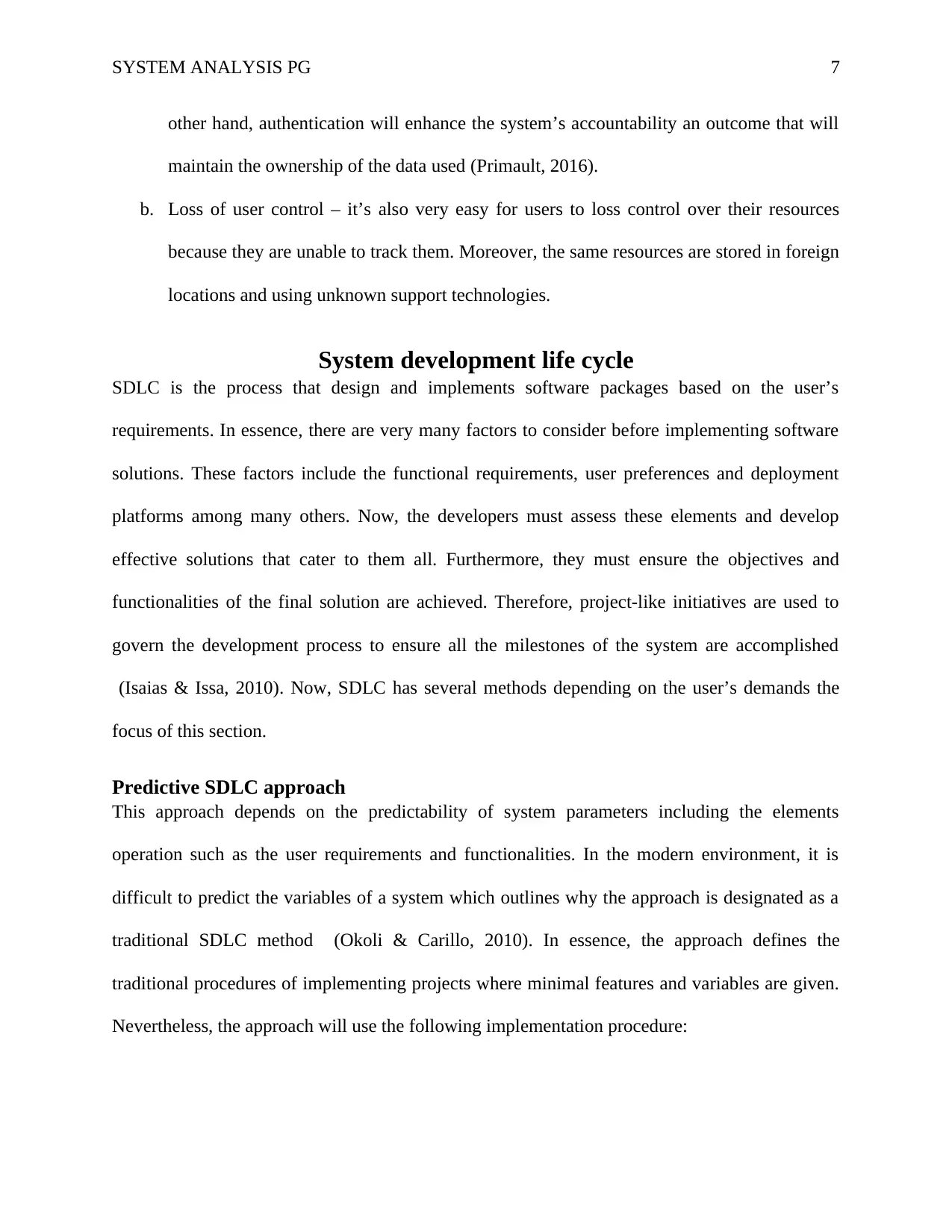
SYSTEM ANALYSIS PG 7
other hand, authentication will enhance the system’s accountability an outcome that will
maintain the ownership of the data used (Primault, 2016).
b. Loss of user control – it’s also very easy for users to loss control over their resources
because they are unable to track them. Moreover, the same resources are stored in foreign
locations and using unknown support technologies.
System development life cycle
SDLC is the process that design and implements software packages based on the user’s
requirements. In essence, there are very many factors to consider before implementing software
solutions. These factors include the functional requirements, user preferences and deployment
platforms among many others. Now, the developers must assess these elements and develop
effective solutions that cater to them all. Furthermore, they must ensure the objectives and
functionalities of the final solution are achieved. Therefore, project-like initiatives are used to
govern the development process to ensure all the milestones of the system are accomplished
(Isaias & Issa, 2010). Now, SDLC has several methods depending on the user’s demands the
focus of this section.
Predictive SDLC approach
This approach depends on the predictability of system parameters including the elements
operation such as the user requirements and functionalities. In the modern environment, it is
difficult to predict the variables of a system which outlines why the approach is designated as a
traditional SDLC method (Okoli & Carillo, 2010). In essence, the approach defines the
traditional procedures of implementing projects where minimal features and variables are given.
Nevertheless, the approach will use the following implementation procedure:
other hand, authentication will enhance the system’s accountability an outcome that will
maintain the ownership of the data used (Primault, 2016).
b. Loss of user control – it’s also very easy for users to loss control over their resources
because they are unable to track them. Moreover, the same resources are stored in foreign
locations and using unknown support technologies.
System development life cycle
SDLC is the process that design and implements software packages based on the user’s
requirements. In essence, there are very many factors to consider before implementing software
solutions. These factors include the functional requirements, user preferences and deployment
platforms among many others. Now, the developers must assess these elements and develop
effective solutions that cater to them all. Furthermore, they must ensure the objectives and
functionalities of the final solution are achieved. Therefore, project-like initiatives are used to
govern the development process to ensure all the milestones of the system are accomplished
(Isaias & Issa, 2010). Now, SDLC has several methods depending on the user’s demands the
focus of this section.
Predictive SDLC approach
This approach depends on the predictability of system parameters including the elements
operation such as the user requirements and functionalities. In the modern environment, it is
difficult to predict the variables of a system which outlines why the approach is designated as a
traditional SDLC method (Okoli & Carillo, 2010). In essence, the approach defines the
traditional procedures of implementing projects where minimal features and variables are given.
Nevertheless, the approach will use the following implementation procedure:
Paraphrase This Document
Need a fresh take? Get an instant paraphrase of this document with our AI Paraphraser

SYSTEM ANALYSIS PG 8
First, the developers define the system’s requirements which will include the
functionalities and the defining user attributes.
These elements are outlined and documented for accountability reasons.
The implementation stages are defined having different functionalities depending on the
system’s requirements and assumptions
From the definition of the system’s requirements, the implementation procedure is
executed having a logical and sequential flow of events. Furthermore, the stages of
implementation must be followed precisely without any form of deviation or overlap
(MSB, 2011).
Therefore, in the end, the approach ends up using a predictable procedure that does not change
regardless of the prevailing conditions. This approach exhibits the following advantages and
disadvantages:
Advantages
a. It is a very simple process that can implement easy and straightforward systems.
b. Furthermore, its strict documentation process enhances accountability as all resources are
closely managed.
c. Finally, it requires minimal technical expertise which minimizes its overall expenditures.
Disadvantages
a. Highly inflexible owing to its inability to adapt to changes, this outcome affects its
overall application.
b. Its also time intensive as all the stages of development must be followed sequentially
without any form of overlap (Peru, 2014).
First, the developers define the system’s requirements which will include the
functionalities and the defining user attributes.
These elements are outlined and documented for accountability reasons.
The implementation stages are defined having different functionalities depending on the
system’s requirements and assumptions
From the definition of the system’s requirements, the implementation procedure is
executed having a logical and sequential flow of events. Furthermore, the stages of
implementation must be followed precisely without any form of deviation or overlap
(MSB, 2011).
Therefore, in the end, the approach ends up using a predictable procedure that does not change
regardless of the prevailing conditions. This approach exhibits the following advantages and
disadvantages:
Advantages
a. It is a very simple process that can implement easy and straightforward systems.
b. Furthermore, its strict documentation process enhances accountability as all resources are
closely managed.
c. Finally, it requires minimal technical expertise which minimizes its overall expenditures.
Disadvantages
a. Highly inflexible owing to its inability to adapt to changes, this outcome affects its
overall application.
b. Its also time intensive as all the stages of development must be followed sequentially
without any form of overlap (Peru, 2014).
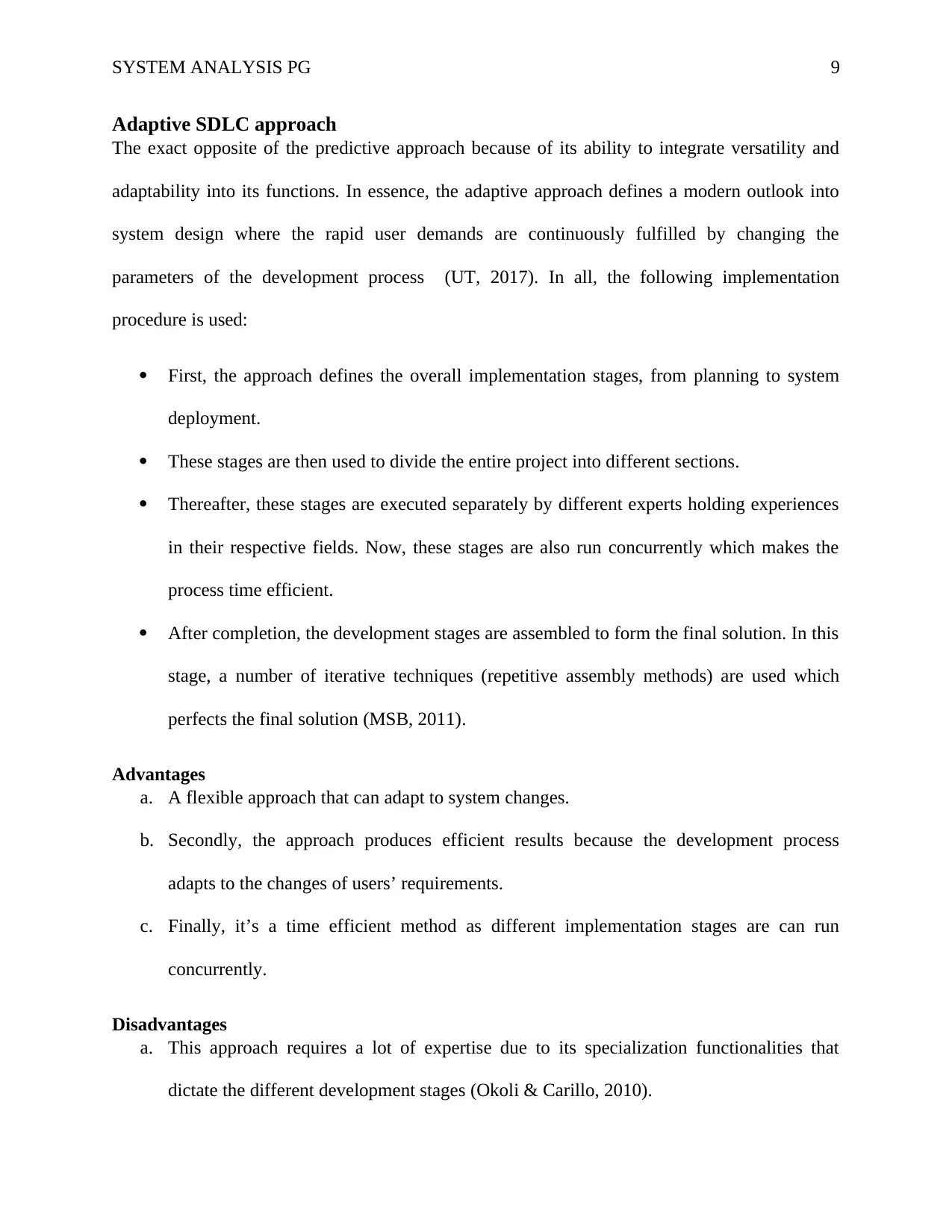
SYSTEM ANALYSIS PG 9
Adaptive SDLC approach
The exact opposite of the predictive approach because of its ability to integrate versatility and
adaptability into its functions. In essence, the adaptive approach defines a modern outlook into
system design where the rapid user demands are continuously fulfilled by changing the
parameters of the development process (UT, 2017). In all, the following implementation
procedure is used:
First, the approach defines the overall implementation stages, from planning to system
deployment.
These stages are then used to divide the entire project into different sections.
Thereafter, these stages are executed separately by different experts holding experiences
in their respective fields. Now, these stages are also run concurrently which makes the
process time efficient.
After completion, the development stages are assembled to form the final solution. In this
stage, a number of iterative techniques (repetitive assembly methods) are used which
perfects the final solution (MSB, 2011).
Advantages
a. A flexible approach that can adapt to system changes.
b. Secondly, the approach produces efficient results because the development process
adapts to the changes of users’ requirements.
c. Finally, it’s a time efficient method as different implementation stages are can run
concurrently.
Disadvantages
a. This approach requires a lot of expertise due to its specialization functionalities that
dictate the different development stages (Okoli & Carillo, 2010).
Adaptive SDLC approach
The exact opposite of the predictive approach because of its ability to integrate versatility and
adaptability into its functions. In essence, the adaptive approach defines a modern outlook into
system design where the rapid user demands are continuously fulfilled by changing the
parameters of the development process (UT, 2017). In all, the following implementation
procedure is used:
First, the approach defines the overall implementation stages, from planning to system
deployment.
These stages are then used to divide the entire project into different sections.
Thereafter, these stages are executed separately by different experts holding experiences
in their respective fields. Now, these stages are also run concurrently which makes the
process time efficient.
After completion, the development stages are assembled to form the final solution. In this
stage, a number of iterative techniques (repetitive assembly methods) are used which
perfects the final solution (MSB, 2011).
Advantages
a. A flexible approach that can adapt to system changes.
b. Secondly, the approach produces efficient results because the development process
adapts to the changes of users’ requirements.
c. Finally, it’s a time efficient method as different implementation stages are can run
concurrently.
Disadvantages
a. This approach requires a lot of expertise due to its specialization functionalities that
dictate the different development stages (Okoli & Carillo, 2010).
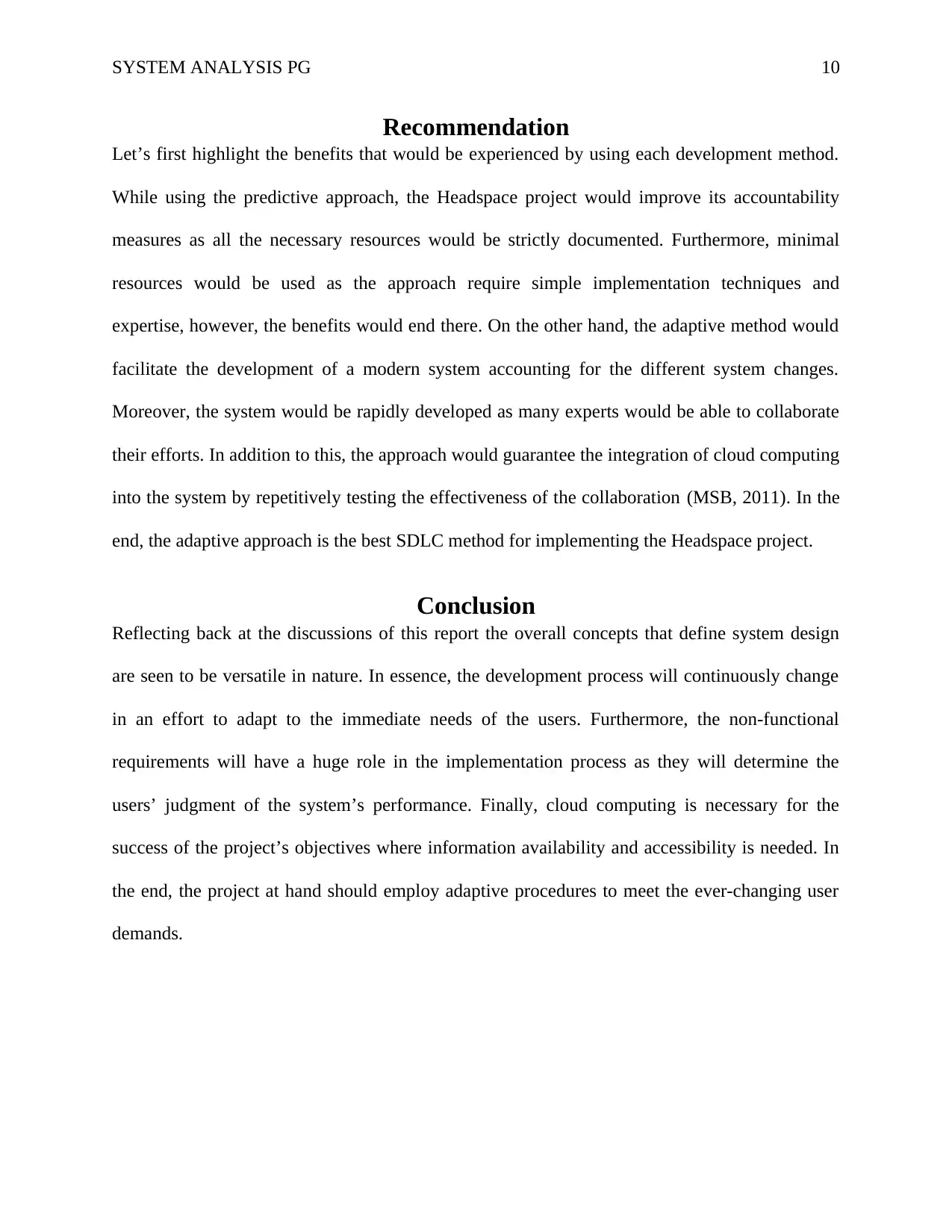
SYSTEM ANALYSIS PG 10
Recommendation
Let’s first highlight the benefits that would be experienced by using each development method.
While using the predictive approach, the Headspace project would improve its accountability
measures as all the necessary resources would be strictly documented. Furthermore, minimal
resources would be used as the approach require simple implementation techniques and
expertise, however, the benefits would end there. On the other hand, the adaptive method would
facilitate the development of a modern system accounting for the different system changes.
Moreover, the system would be rapidly developed as many experts would be able to collaborate
their efforts. In addition to this, the approach would guarantee the integration of cloud computing
into the system by repetitively testing the effectiveness of the collaboration (MSB, 2011). In the
end, the adaptive approach is the best SDLC method for implementing the Headspace project.
Conclusion
Reflecting back at the discussions of this report the overall concepts that define system design
are seen to be versatile in nature. In essence, the development process will continuously change
in an effort to adapt to the immediate needs of the users. Furthermore, the non-functional
requirements will have a huge role in the implementation process as they will determine the
users’ judgment of the system’s performance. Finally, cloud computing is necessary for the
success of the project’s objectives where information availability and accessibility is needed. In
the end, the project at hand should employ adaptive procedures to meet the ever-changing user
demands.
Recommendation
Let’s first highlight the benefits that would be experienced by using each development method.
While using the predictive approach, the Headspace project would improve its accountability
measures as all the necessary resources would be strictly documented. Furthermore, minimal
resources would be used as the approach require simple implementation techniques and
expertise, however, the benefits would end there. On the other hand, the adaptive method would
facilitate the development of a modern system accounting for the different system changes.
Moreover, the system would be rapidly developed as many experts would be able to collaborate
their efforts. In addition to this, the approach would guarantee the integration of cloud computing
into the system by repetitively testing the effectiveness of the collaboration (MSB, 2011). In the
end, the adaptive approach is the best SDLC method for implementing the Headspace project.
Conclusion
Reflecting back at the discussions of this report the overall concepts that define system design
are seen to be versatile in nature. In essence, the development process will continuously change
in an effort to adapt to the immediate needs of the users. Furthermore, the non-functional
requirements will have a huge role in the implementation process as they will determine the
users’ judgment of the system’s performance. Finally, cloud computing is necessary for the
success of the project’s objectives where information availability and accessibility is needed. In
the end, the project at hand should employ adaptive procedures to meet the ever-changing user
demands.
Secure Best Marks with AI Grader
Need help grading? Try our AI Grader for instant feedback on your assignments.
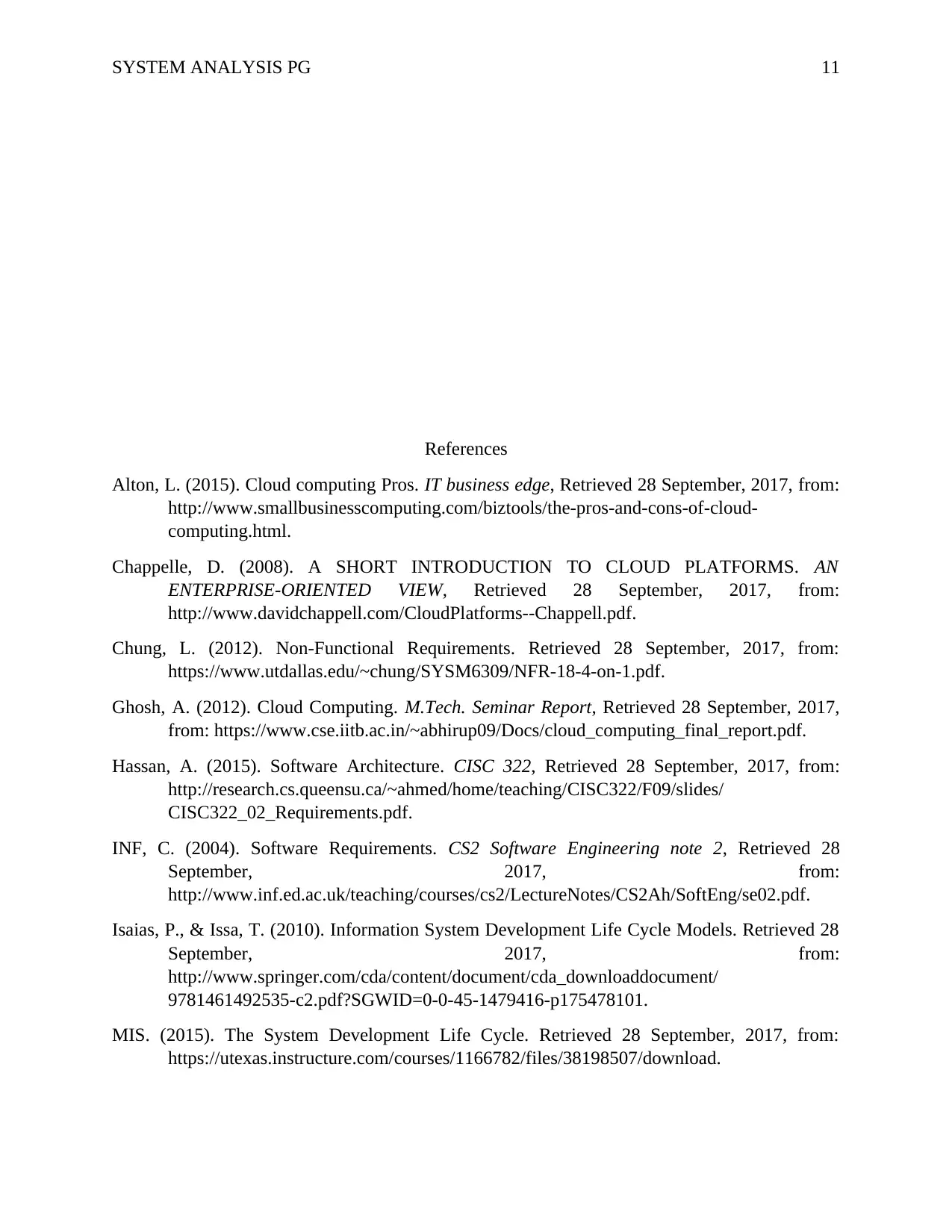
SYSTEM ANALYSIS PG 11
References
Alton, L. (2015). Cloud computing Pros. IT business edge, Retrieved 28 September, 2017, from:
http://www.smallbusinesscomputing.com/biztools/the-pros-and-cons-of-cloud-
computing.html.
Chappelle, D. (2008). A SHORT INTRODUCTION TO CLOUD PLATFORMS. AN
ENTERPRISE-ORIENTED VIEW, Retrieved 28 September, 2017, from:
http://www.davidchappell.com/CloudPlatforms--Chappell.pdf.
Chung, L. (2012). Non-Functional Requirements. Retrieved 28 September, 2017, from:
https://www.utdallas.edu/~chung/SYSM6309/NFR-18-4-on-1.pdf.
Ghosh, A. (2012). Cloud Computing. M.Tech. Seminar Report, Retrieved 28 September, 2017,
from: https://www.cse.iitb.ac.in/~abhirup09/Docs/cloud_computing_final_report.pdf.
Hassan, A. (2015). Software Architecture. CISC 322, Retrieved 28 September, 2017, from:
http://research.cs.queensu.ca/~ahmed/home/teaching/CISC322/F09/slides/
CISC322_02_Requirements.pdf.
INF, C. (2004). Software Requirements. CS2 Software Engineering note 2, Retrieved 28
September, 2017, from:
http://www.inf.ed.ac.uk/teaching/courses/cs2/LectureNotes/CS2Ah/SoftEng/se02.pdf.
Isaias, P., & Issa, T. (2010). Information System Development Life Cycle Models. Retrieved 28
September, 2017, from:
http://www.springer.com/cda/content/document/cda_downloaddocument/
9781461492535-c2.pdf?SGWID=0-0-45-1479416-p175478101.
MIS. (2015). The System Development Life Cycle. Retrieved 28 September, 2017, from:
https://utexas.instructure.com/courses/1166782/files/38198507/download.
References
Alton, L. (2015). Cloud computing Pros. IT business edge, Retrieved 28 September, 2017, from:
http://www.smallbusinesscomputing.com/biztools/the-pros-and-cons-of-cloud-
computing.html.
Chappelle, D. (2008). A SHORT INTRODUCTION TO CLOUD PLATFORMS. AN
ENTERPRISE-ORIENTED VIEW, Retrieved 28 September, 2017, from:
http://www.davidchappell.com/CloudPlatforms--Chappell.pdf.
Chung, L. (2012). Non-Functional Requirements. Retrieved 28 September, 2017, from:
https://www.utdallas.edu/~chung/SYSM6309/NFR-18-4-on-1.pdf.
Ghosh, A. (2012). Cloud Computing. M.Tech. Seminar Report, Retrieved 28 September, 2017,
from: https://www.cse.iitb.ac.in/~abhirup09/Docs/cloud_computing_final_report.pdf.
Hassan, A. (2015). Software Architecture. CISC 322, Retrieved 28 September, 2017, from:
http://research.cs.queensu.ca/~ahmed/home/teaching/CISC322/F09/slides/
CISC322_02_Requirements.pdf.
INF, C. (2004). Software Requirements. CS2 Software Engineering note 2, Retrieved 28
September, 2017, from:
http://www.inf.ed.ac.uk/teaching/courses/cs2/LectureNotes/CS2Ah/SoftEng/se02.pdf.
Isaias, P., & Issa, T. (2010). Information System Development Life Cycle Models. Retrieved 28
September, 2017, from:
http://www.springer.com/cda/content/document/cda_downloaddocument/
9781461492535-c2.pdf?SGWID=0-0-45-1479416-p175478101.
MIS. (2015). The System Development Life Cycle. Retrieved 28 September, 2017, from:
https://utexas.instructure.com/courses/1166782/files/38198507/download.
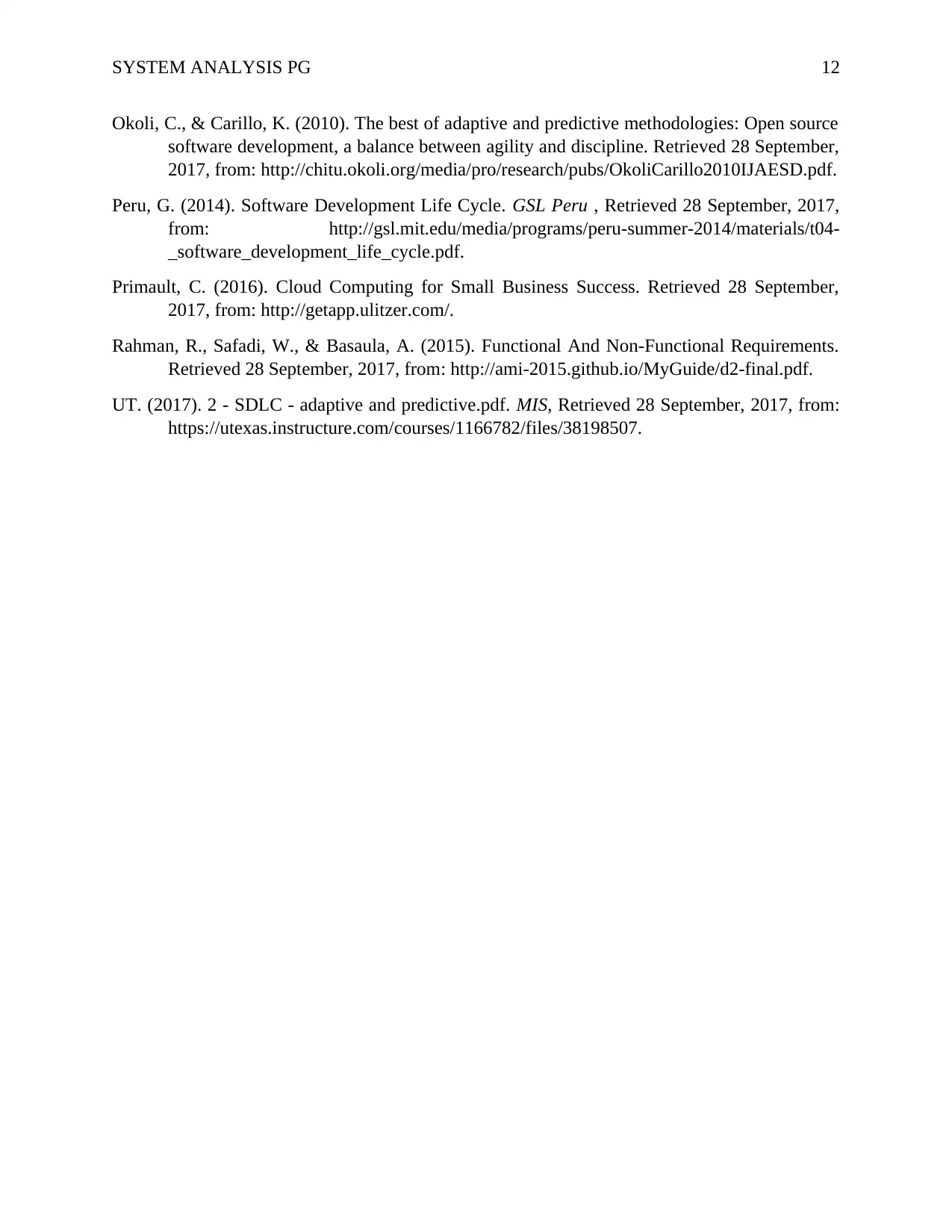
SYSTEM ANALYSIS PG 12
Okoli, C., & Carillo, K. (2010). The best of adaptive and predictive methodologies: Open source
software development, a balance between agility and discipline. Retrieved 28 September,
2017, from: http://chitu.okoli.org/media/pro/research/pubs/OkoliCarillo2010IJAESD.pdf.
Peru, G. (2014). Software Development Life Cycle. GSL Peru , Retrieved 28 September, 2017,
from: http://gsl.mit.edu/media/programs/peru-summer-2014/materials/t04-
_software_development_life_cycle.pdf.
Primault, C. (2016). Cloud Computing for Small Business Success. Retrieved 28 September,
2017, from: http://getapp.ulitzer.com/.
Rahman, R., Safadi, W., & Basaula, A. (2015). Functional And Non-Functional Requirements.
Retrieved 28 September, 2017, from: http://ami-2015.github.io/MyGuide/d2-final.pdf.
UT. (2017). 2 - SDLC - adaptive and predictive.pdf. MIS, Retrieved 28 September, 2017, from:
https://utexas.instructure.com/courses/1166782/files/38198507.
Okoli, C., & Carillo, K. (2010). The best of adaptive and predictive methodologies: Open source
software development, a balance between agility and discipline. Retrieved 28 September,
2017, from: http://chitu.okoli.org/media/pro/research/pubs/OkoliCarillo2010IJAESD.pdf.
Peru, G. (2014). Software Development Life Cycle. GSL Peru , Retrieved 28 September, 2017,
from: http://gsl.mit.edu/media/programs/peru-summer-2014/materials/t04-
_software_development_life_cycle.pdf.
Primault, C. (2016). Cloud Computing for Small Business Success. Retrieved 28 September,
2017, from: http://getapp.ulitzer.com/.
Rahman, R., Safadi, W., & Basaula, A. (2015). Functional And Non-Functional Requirements.
Retrieved 28 September, 2017, from: http://ami-2015.github.io/MyGuide/d2-final.pdf.
UT. (2017). 2 - SDLC - adaptive and predictive.pdf. MIS, Retrieved 28 September, 2017, from:
https://utexas.instructure.com/courses/1166782/files/38198507.
1 out of 12
Related Documents
Your All-in-One AI-Powered Toolkit for Academic Success.
+13062052269
info@desklib.com
Available 24*7 on WhatsApp / Email
![[object Object]](/_next/static/media/star-bottom.7253800d.svg)
Unlock your academic potential
© 2024 | Zucol Services PVT LTD | All rights reserved.





